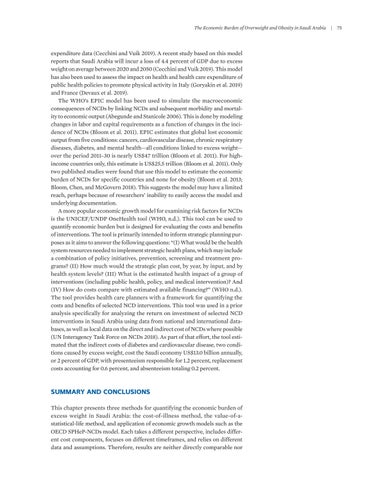The Economic Burden of Overweight and Obesity in Saudi Arabia
expenditure data (Cecchini and Vuik 2019). A recent study based on this model reports that Saudi Arabia will incur a loss of 4.4 percent of GDP due to excess weight on average between 2020 and 2050 (Cecchini and Vuik 2019). This model has also been used to assess the impact on health and health care expenditure of public health policies to promote physical activity in Italy (Goryakin et al. 2019) and France (Devaux et al. 2019). The WHO’s EPIC model has been used to simulate the macroeconomic consequences of NCDs by linking NCDs and subsequent morbidity and mortality to economic output (Abegunde and Stanicole 2006). This is done by modeling changes in labor and capital requirements as a function of changes in the incidence of NCDs (Bloom et al. 2011). EPIC estimates that global lost economic output from five conditions: cancers, cardiovascular disease, chronic respiratory diseases, diabetes, and mental health—all conditions linked to excess weight— over the period 2011–30 is nearly US$47 trillion (Bloom et al. 2011). For high- income countries only, this estimate is US$25.5 trillion (Bloom et al. 2011). Only two published studies were found that use this model to estimate the economic burden of NCDs for specific countries and none for obesity (Bloom et al. 2013; Bloom, Chen, and McGovern 2018). This suggests the model may have a limited reach, perhaps because of researchers’ inability to easily access the model and underlying documentation. A more popular economic growth model for examining risk factors for NCDs is the UNICEF/UNDP OneHealth tool (WHO, n.d.). This tool can be used to quantify economic burden but is designed for evaluating the costs and benefits of interventions. The tool is primarily intended to inform strategic planning purposes as it aims to answer the following questions: “(I) What would be the health system resources needed to implement strategic health plans, which may include a combination of policy initiatives, prevention, screening and treatment programs? (II) How much would the strategic plan cost, by year, by input, and by health system levels? (III) What is the estimated health impact of a group of interventions (including public health, policy, and medical intervention)? And (IV) How do costs compare with estimated available financing?” (WHO n.d.). The tool provides health care planners with a framework for quantifying the costs and benefits of selected NCD interventions. This tool was used in a prior analysis specifically for analyzing the return on investment of selected NCD interventions in Saudi Arabia using data from national and international databases, as well as local data on the direct and indirect cost of NCDs where possible (UN Interagency Task Force on NCDs 2018). As part of that effort, the tool estimated that the indirect costs of diabetes and cardiovascular disease, two conditions caused by excess weight, cost the Saudi economy US$13.0 billion annually, or 2 percent of GDP, with presenteeism responsible for 1.2 percent, replacement costs accounting for 0.6 percent, and absenteeism totaling 0.2 percent.
SUMMARY AND CONCLUSIONS This chapter presents three methods for quantifying the economic burden of excess weight in Saudi Arabia: the cost-of-illness method, the value-of-a- statistical-life method, and application of economic growth models such as the OECD SPHeP-NCDs model. Each takes a different perspective, includes different cost components, focuses on different timeframes, and relies on different data and assumptions. Therefore, results are neither directly comparable nor
|
75






